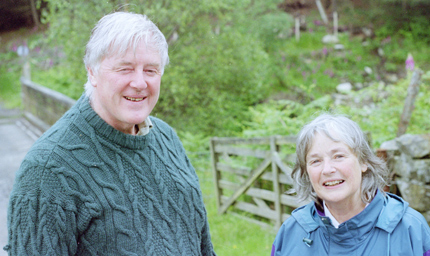
On leaving Radley in 1956 I took up an engineering apprenticeship with Saunders-Roe Ltd., East Cowes, Isle of Wight. This was a company that took great pride in the quality of its workmanship, and apprentices were given great education in metal work and engineering drawing. The Superintendent of Training was V.T. Stevenson who cared greatly for his charges and thought the world of me; musical people used to sit and listen to classical music in an elaborate studio he had in his home. We had old cars which we would spend all our time fixing. I had an Austin 7 which one could drive along the pavement between a bounding wall and the lampposts. It used to develop violent vibrations on building up speed down the Isle of Wight's longest hill, rather like an aircraft encountering the sound barrier.
CANOEING ON THE SOLENT
Out upon the wide expanse of the Solent
I am free to paddle my kayak canoe.
I can go anywhere - I enjoy the freedom of the deep.
The tidal currents carry me effortlessly
past the large can buoys which mark the navigable channels.
I paddle out of the way of other boats near Cowes
and allow the waters to carry me to Yarmouth.
On the way I simply sit and read -
enjoying the sunshine and the warmth
of a summer day. I paddle out of the way of other boats
and the occasional ship visiting Southampton.
In Yarmouth I land my canoe, and visit a pub for a pint.
In the afternoon the currents are reversed
and the waters carry me peacefully back home.
On one occasion I read a substantial portion of Charles Dickens' novel David Copperfield.
I became a crew on big yachts on trips across the English Channel to France. I wasn't particularly smart or quick-witted on a boat, but I never got seasick. I have strong stomach muscles from my habit since infancy of "rocking", rolling from side to side in bed. I used to be content in bad weather to be left alone at the helm for hours on end while everybody else went below decks for shelter. I love to be at sea in a small boat. It's so clean, and the sea generally conveys a wealth of information. Many hours at sea go by, with interesting companions, but long conversations don't occur. The boat is alive and wants attention.
Victor Stevenson and my parents and I collaborated in strenuous efforts for me to go to Oxford or Cambridge. I went for tutoring, and applied to all of the colleges. I was admitted by St John's College Cambridge, probably because they had a shortage of people with my background. On admission to read Engineering I instantly changed subject to Natural Sciences. I spent my first year living out and my second year in First Court with John Kurtz, wealthy and cultivated medical student. Part I in Physics of the Natural Sciences Tripos was difficult; so not knowing that I would get a 2.1 after the first two years, I opted for the easiest looking option for Part II – Metallurgy. That last year I roomed with John Lewis in New Court, through the cold winter of 1962-3, when we grew ice on our windows. We were friends with R.D.Tim Oliver; he had a light and easy manner, and that's how I thought of him. Norman Macmillan, student of metallurgy at Selwyn College, was hugely brainy. He was an athletic dinghy sailor. We frequented the Cruising Club. With amused condescension he called me "our Charles". I perforce became a metallurgist, and on graduating went to the Research Labs of Johnson Matthey in Wembley. Molybdenum has strength at high temperatures, but readily dissolves into gaseous yellow molybdenum trioxide, so if one wants to stir molten glass with a molybdenum rod, one has first to coat it with platinum. However there are then problems with intermetallic compounds, and one has to use alumina as an intermediary.
This work was very interesting, but I lived to go sailing at the weekends. I lived in Lansdowne Road, Notting Hill Gate with Peter Wingfield-Stratford, and used to ride with him to work, and go sailing with him at weekends with Commander Edwin Morrison, RN. We also worked on renovation at Dduallt Station of the mountain railway from Rheilfford up to Blaenau Ffestiniog in Wales. The photo below, taken on 28 June 98, shows Peter with the poet Frances Jessup when we attended a reunion at Dduallt.

At St John's College I met Harry Carter-Jonas, estate agent, who took me on as crew for his Nicholson 36 fibreglass boat Heyli. I became a member of the Royal Ocean Racing Club. We obtained rather poor results in RORC races, because Harry was a very careful seaman who took good care of his boat and his crew of six.
--------------------------------------------------------------------------------------------------------------
CHANGE OF WATCH: ON
Charles !
OK gotcha.
NOW
That means sweater
It means oilskins bottoms
It means oilskins top
NOW. UGH. Thank you.
It means Boots - little sea boots.
It means yellow towel scarf
around the neck.
Thank you.
Now go
Up you get
through the hatch
Into the bloody weather!
Right.
Excuse me!
Just what's going on?
It's 0400
and now there isn't any weather.
Everything is calm.
We're barely moving.
This I do not believe.
No Force 4-5 any more;
Force 1 if we're lucky.
Four hours ago there really was Force 4
I'm sure of it.
Now there's just a little gentle lapping
of little waves plopping against the hull.
Magic.
And the colours in the sky - red but not familiar
something I've never seen before
won't ever see again. Gorgeous.
Look up. I see.
Seems OK, but ...
The damn things flapping a bit.
Try sitting on the side of the cockpit
to give a bit of a heel;
that's better.
OK? Yes we're OK!
Milk and sugar, right?
Yes indeed. Thanks!
----------------------------------------------------------------------------------------------
HENRY O. J. CARTER-JONAS
Affectionately he was known to all
as Harry. One came when e'er he gave the call.
Not high in stature, but not small
tough as anything: a wall.
Of me he was uncommon fond
and soon we had a great great bond.
His profession Agent was, Estate;
Not likely then to call one Mate.
We used to look on tourists on the beach
so far away, so glad they're out of reach.
We were the most appalling snobs,
high and greatest overhelming Nobs.
He helped me on to go and join the RORC
plucking me out of background like a stork.
Royal Ocean Racing Club no less
can only 'llow admission of the best -
proposed and seconded by Members
glowing themselves like embers
of hot enthusiastic fire
right down to the wire.
He had a gentle touch.
He gave me much.
------------------------------------------------------------------------------------------------------------------
Harry's wife Jeannie was a different story; we called her the Admiral. She was very gung-ho. I took to the role of navigator, and would spend most of the hours of a two-day RORC race listening to Radio direction finder signals, or gazing through a hand-bearing compass and studying charts and tide tables. “I gave you 275 for a course, Jeannie. What have you actually steered?” “285: I think that makes better sense.” “Ah, well that would explain things.” We used to argue loudly. On the Fastnet Race of 1965 we approached the Fastnet Rock in calm conditions; people a mile away later told us that they could hear us shouting at one another as we argued about the optimum course to steer. As a navigator, the satisfaction was enormous of having the mark of a course appear where it should on the horizon ahead at roughly the time anticipated.
I sailed also with Chris Carter-Jonas, Harry's brother. The Harwich - Hook of Holland race of 16 May 64 was my first recorded RORC Race. We did not do very well - 4 hours behind Harry, my usual skipper. Calmly sailing home in calm weather after our exertions I was on watch with Major Bill Gamblin (Royal Canadian Horse Artillery), then living in London. We were enjoying a bit of peace. Then explosions were going on about 1/2 a mile away, discernible through our hull. We noticed ahead a ship sporting a vertical row of balls. Bill went below for Reed's Nautical Almanac to try to figure out what these meant. We closed on the ship. As we crossed behind it 3/4 mile away on our port side a big yellow can came hurtling towards our starboard side about 20 m away. I cut the propeller and Bill cut the engine. We passed over a rubber towing cable of a detonator used for explosions for Dutch seismic studies of oil. No harm was done. Bill and I kept quiet about our little excitement.
My scariest time on a boat was along a narrow channel crossing the Dutch Ijsselmeer with an Australian and two others in 1963 on a month's cruise among the Danish islands. I was steering on the orders of a lookout in the bows, keeping clear of the reed marks of the channel. It was blowing Force 6 with low visibility and I had no sense of where we were going; we could readily have gone aground in the shallow and choppy water.
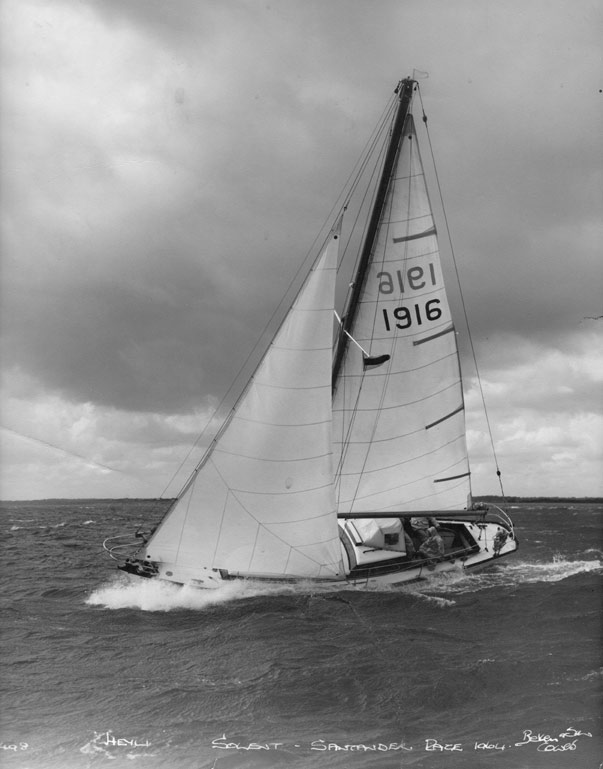
On 15 Aug 64 while cleaning Heyli's topsides I passed Pen Duick II: There was the famous trans-Atlantic sailor Eric Tabarly. I said "J'espére que vous allez écrire un libre (livre) pour l'hier (hiver)". He said Yes in French and then after a pause invited me aboard. I got over my nervousness asking him about his Walker Log. He said a dolphin had eaten his rotor twice. His navigation table was mounted on gimbals, huge and dry and level. The boat looked badly made inside, many thin unpainted plywood bulkheads & deep lockers. It was just a badly ventilated shell, with an observation platform underneath a semispherical dome which made the boat very hot. A crude high stability hull supported a main mast with four enclosed French winches (main, genoa, staysail and spinnaker) and a simple little mizzen. Everything was very "thin" - one could almost have put thumb and forefinger round the main boom - and light. Eric himself was charming, very humbly proud, and often looking at his Pa for encouragement. Talking of record passages, he said that he could have had two days off his time had his steering not failed at 8 days. The papers were right in saying that he only got 1½ hr sleep at a stretch; always he was woken up by the boat going off course or off trim. The passage might well stand as a record because the winds were favourable! He implied that he would enter in 1968, when it would be more difficult to win. Another chap asked if he particularly feared any other competition and he implied that he didn't think of them much; and thought radio a handicap. I told him how Francis Chichester said he could smell him. Tabarly praised Chichester. He is a simple man and keen like a small boy: he gave me a nice smile that evening in the bar as we passed.
I went back to Heyli after Harry loudly hailed me. Then I let the Avon dinghy go after omitting to tie it up & had to strip and dive in after it! Very excited, for about 15 minutes I had enjoyed an exclusive interview with one of the world's sailing greats, record holder sailing single-handed across the Atlantic.
The Solent-Santander Race was followed by the Santander-La Trinité race in to the French coast. The weather became stormy and seas built up on the shelving shore of the Bay of Biscay, just a few huge waves visible out to the horizon. I saw a whole school of porpoises in the trough of one wave. For a long time I was given the helm so that more experienced people could get a rest before handling our approach to the French coast: a lee shore is always dangerous.
-----------------------------------------------------------------------------------------------------------------
CHANGE OF WATCH: OFF
The Santander-La Trinité Race. RORC. 16 - 18 Aug 1964
Mon 2300- Tues 0300. 4½-5 knots on 355º. Storm jib. A little tiny triangle. Force 9. In those days rarely encountered.
I had the whole Universe to myself.
It was an unforgettable event
in my Life.
My night stint was to save Edward
for the lee shore entrance.
It was very picturesque at times;
cold and exhausting on body and on nerves.
White anvil clouds and thunderstorms
passed by.
How much Edward was conserved
I know not.
He said - reluctantly I thought -
'.. grand job' .
I ache in every limb
I am numb.
I hurt.
Barely can I move
I am so stiff.
'OK Charlie we're coming'
Relieved: Yes.
They caught me well in time;
I was not dead beat
just nearly beaten dead.
I did what I was told;
made for the hatch
went down below
fell to my bunk - numb.
--------------------------------------------------------------------------------------------------------
One would receive foam and spray at the top of a wave, and then need a strong helm to maintain course when the wave passed and the boat accelerated down into the relative calm of the succeeding trough. Such sailing is an exhilarating exercise of craftsmanship. From other boats five lives were lost of sailors washed overboard.
After this race I took a bus ride to Chartres and was restored by the stained glass windows of the Cathedral.
Early in October 1964 Commander Morrison, Peter Wingfield-Stratford and I sailed the yacht Chasseur from Lymington to Burnham. Motoring slowly up the estuary of the River Crouch in fog, we steered from buoy by buoy, and dropped anchor a few hundred metres from the Royal Corinthian Yacht Club – totally invisible in the fog.
I left Johnson Matthey to sail the Atlantic. Jenny Wright, quietly friendly, loyal and capable, was the skipper's first mate; after a dinner in London she hired me on behalf of D. F. Southern. With him I did not get on. He was like an eagle: His new Hillyard sloop Aguila was of massively strong construction, built for comfortable cruising. He had been let down by a friend and needed crew for the passage across the Atlantic. Dean Jones, taciturn and pragmatic, an architect, was his other crew member. We departed Littlehampton on 29 September 1965. This was not a happy voyage; we kept to ourselves most of the time. Our food was sufficient and no more. I was given watches from 0200-0600 and 1400-1800, the least interesting times of day.
Somewhere not far from the island of Madeira, our first destination, we were beating - sailing in a direction not far from that whence the wind was blowing. This is comfortable. The boat heels as the sails draw force from the winds flowing over their aerofoil shapes. A certain amount of force from the rudder is applied at the helm: the keel has to be a hydrofoil. Skill is required to make the best speed to windward. I was alone on deck, contented as usual, when fairly suddenly a gale force gust came along and the boat heeled over dramatically. The skipper appeared in the hatchway. Fine by me; I luffed up into the wind to take most of the force out of the sails; I knew that the boat was good and strong. Sail was soon shortened and on we went.
We reached Funchal, Madeira, on 14 October. It was an attractive resort, protected from adverse weather by mountains on its north side. Here we enjoyed finding different plants, notably rhododendron, in gardens at different heights above the town. We bought fresh bananas: they tasted sweet, like oranges.
We spent another 30 days on passage across the great Atlantic Ocean. It was fresh and blue and beautiful, but not particularly interesting. In the northeasterly trade winds, with the wind coming from behind at a slight angle, we sailed comfortably and pleasingly on a broad reach; this was not a RORC race. I detected no singularity when we crossed the Mid-Atlantic Ridge on the sea floor 2000 m below. Later as a meteorologist I learned about the pulses (sweepers) that propagate through the trade winds, now made visible in time-lapse movies from satellite data.
Comet Ikeya-Seki, seen low in the sky behind us shortly before dawn, reached perihelion on 21 October and broke into three pieces; it always appeared as one.
We reached Bridgetown, Barbados on 18 November. From there I walked tearfully ~18 km across the island, and looked for a meteorological job at the airport.
Happily Huey Long's skipper Sven Joffs was looking for crew for the “Ondine”, a magnificent aluminium yacht which he wanted delivering from Barbados to San Diego, in preparation for the trans-Pacific race. He would pay $100 for the voyage, enough for the Greyhound Bus fair to Montreal, where I hoped to meet up with girl friend Christiane Schweiger, and find work as a metallurgist. Dean Jones and I enjoyed immensely an infinite supply of peanut butter. Sven took to me for a short time. He didn't like riff-raff or sand, and hardly ever went ashore. He swore horribly, and we called him a pipe-sucker. Huey Long put in an appearance with a delicate blonde girl he had picked up in Las Vegas, but he soon tired of her and left his crew to entertain her as we cruised the Leeward Islands. I went for a swim and got a sea-urchin spine in a foot, which had to be removed at a hospital; I was given a candle to burn for the grease to heal the wound. This did not please Sven. We traversed the magnificent Panama Canal; I spent the whole time down below reading and so missed it.
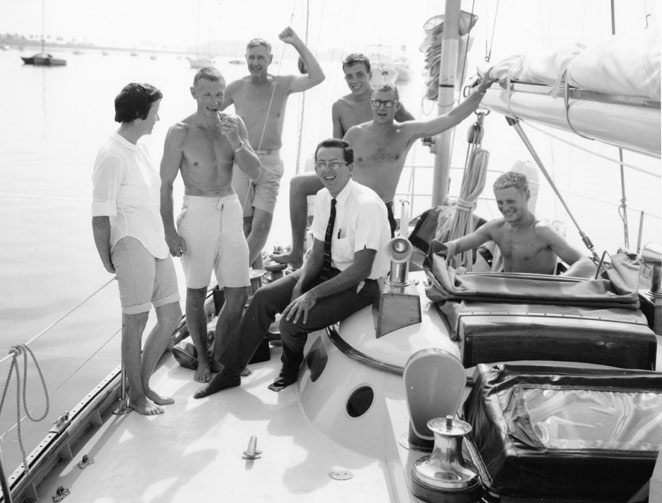


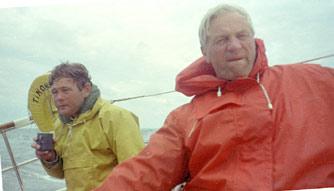
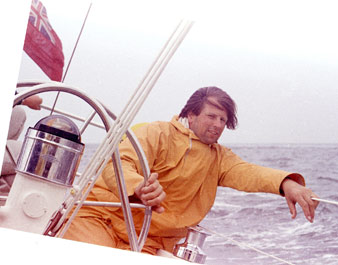
-----------------------------------------------------------------------------------------------------------
COMMANDER EDWIN ALLEN MORRISON RN
Sir!
Shall I compare thee to a summer's day?
I'd rather you didn't Charlie.
You feel to me like that
as it happens.
You are so very very tough;
of that I can see ne'er enough.
You get so very very wet;
'deed wetter times were never met.
I love the way you shout and yell
as tho' we're entering all Hell
though 'tis is merely just a Race
and you're not happy with the Pace.
Oh HURRY UP
you silly clown
can't you tell your up from down?
With frothing at the mouth sometimes
when satisfaction rang no chimes.
I do wish you'd just GET IT UP
you silly worthless little pup.
If you leave that lying there
it looks as though you do not care.
When all is done there's total peaceful calm.
He had a pleasing simple child-like charm.
With him none ever would see harm
or ever feel a twinge of some alarm.
I was so lucky under him to serve -
far better than I ever did deserve.
----------------------------------------------------------------------------------------------
SPINNAKER
We're going down down the wind
which is from behind
but a little to one side
let's say on the right or starboard side.
(This contrasts with a brutal Beat -
the other way - into the wind.)
Our boat has length 36 feet something like that.
A huge and gorgeous animal
in its own right. Respect.
We glory in a Reach, a little across the wind,
the very best sensation, the fastest,
or - wobbly hazardous and slow - a Run
down down the restless fickle wind.
Yes! The spinnaker - at
The spinnaker is a big triangular sail.
At the top a Head, a skyward spear
attached by halyard at the mast head.
At bottom right the Tack,
the low corner to windward;
At bottom left the Clew
the low corner on the port or left hand side -
now in the lee on the leeward side.
And thus we have the mighty triangle.
Coloured with angry lurid patterns
of colour and aggressive shape,
it lives and moves; it's never still.
It's delicate: the fabric
is silk or something chemical and subtle,
very very light and very strong.
It is controlled, this magic rippling thing
by spinnaker boom from base of mast to Tack,
a rigid arm which can rotate in quasi-horizontal plane
and pitch, a little.
The Guy holds this bobbing boom
holds it down and holds it back.
The Sheet attached to the Clew led far far aft
right to the stern of boat on port, the left hand side
very long and moving to and fro
with the Clew.
Ferocious forces in the Guy and Sheet
(in masthead too of course, unseen),
the giant bubble pulls
forwards and slightly upwards.
There we have balance.
As the boat overtakes the waves it lifts and turns.
Compensation on the helm
by Timonier, our Helmsman
(of course our boat is named):
an idle, gentle, then a forceful hand.
Timonier has to learn
to know, to Dance
slowly and with sympathy
a slow and powerful foxtrot
(more like a foxwalk if you ask).
Feeling the movement
and the rhythm of the moving sea
withall the moving boat beneath
(pitch and yaw and roll).
The shape is then full round, a huge bubble
drawing us along. Remorseless lifting power.
----------------------------------------------------------------------------------------------------------
After I returned from the University of Virginia I sailed once or twice with Commander Morrison in 1985. During the brief period when I was at Oxford I occasionally became unreliable due to migraine headaches, and took up running as my main sport.